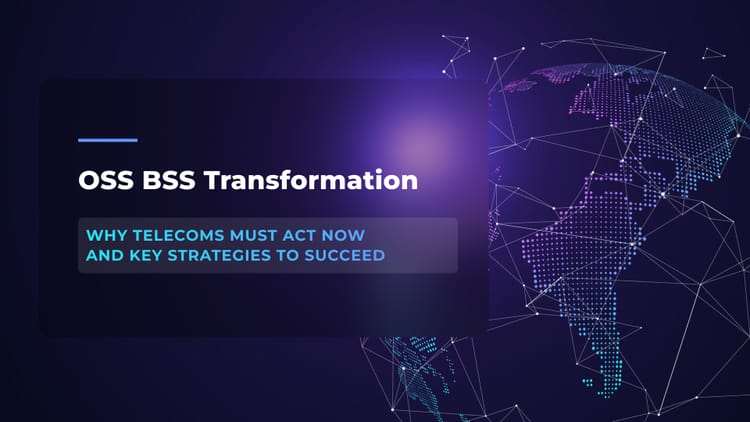Telecom Digital Transformation: Exploring the Potential for a Competitive Edge

Telcos worldwide are dealing with a gradual decline in revenue from traditional services. The main reason for such a decline is the introduction of new and more in-demand services around smart homes, IoT, e-health, and connected cars, as well as digital technologies like cloud computing, robotic process automation (RPA), IoT, AI, and 5G that offer increased speeds and enhanced connectivity. So, to stay relevant and introduce new services promptly in the ever-changing market, digital transformation has become crucial for many telcos.
At Flyaps, we've been collaborating closely with industry giants like Yaana Technologies for over a decade, helping them transform their business operations in the most effective way possible. In this article, we’d like to delve into the intricacies of digital transformation for telecom companies, exploring the opportunities it unlocks through real-life examples. Plus, we'll guide you through successful ways to make digital transformation work smoothly, so keep reading.
But before we dive into specific examples and successful approaches to adopting digital transformation in the telecom industry, let's first clear the air around the essence of "digital transformation" in this context.
What is digital transformation in telco?
Digital transformation in telecom involves a significant overhaul of how telecom companies offer their services by integrating cutting-edge digital technologies into their operations. This transformation covers various aspects, such as:
- Phone services: When telecom companies introduce features like high-definition voice calls, video conferencing, and seamless integration with messaging applications instead of being limited to traditional phone services.
- Internet services: If, apart from basic internet connectivity, telcos offer lightning-fast broadband, fiber-optic connections, and even satellite-based internet for remote areas. For instance, traditional telecom operators might invest in advanced infrastructure to ensure high-speed internet access in rural regions, enabling previously underserved communities to become part of the digital world.
- Television services: When telcos, for instance, move from traditional cable to IPTV (Internet Protocol Television). This allows users to stream content over the internet, access interactive features, on-demand programming, and personalized content recommendations.
- Networks for businesses and homes: For instance, a telecom company might develop smart home solutions for customers to control their lights, security systems, and appliances through a mobile app. On the business side, telecom companies can provide advanced networking options that ensure seamless connectivity and robust cybersecurity features.
The wave of digitalization is sweeping across various industries, extending far beyond just the telecom industry. The projected expansion of the digital transformation market is to surge from its current valuation of $695.5 billion in 2023 to a staggering $3,144.9 billion by 2030. This equals to 24.1% of a Compound Annual Growth Rate (CAGR) during the forecast period.
The impact of digitalization can no longer be taken lightly. For businesses, regardless of their industry, neglecting this ever-accelerating trend could lead to a loss of customers and revenue streams. As we're focusing on telecom companies here, let's highlight the consequences for telcos specifically if they decide not to adopt digital technologies.
From cloud migration to telecom-specific AI solutions, we have delivered over 20 projects that are used by hundreds of MNOs and telecom companies worldwide. Check our capabilities and let’s discuss your next solution.
See our servicesNeglecting telco digital transformation: the outcomes
The adoption of digital technologies has grown from being an option to a necessity. However, various factors can prompt telecom companies to delay the process, with budget constraints being a significant one. Neglecting digital transformation can lead to serious consequences for the telecom business. Here are some of the most vital threats:
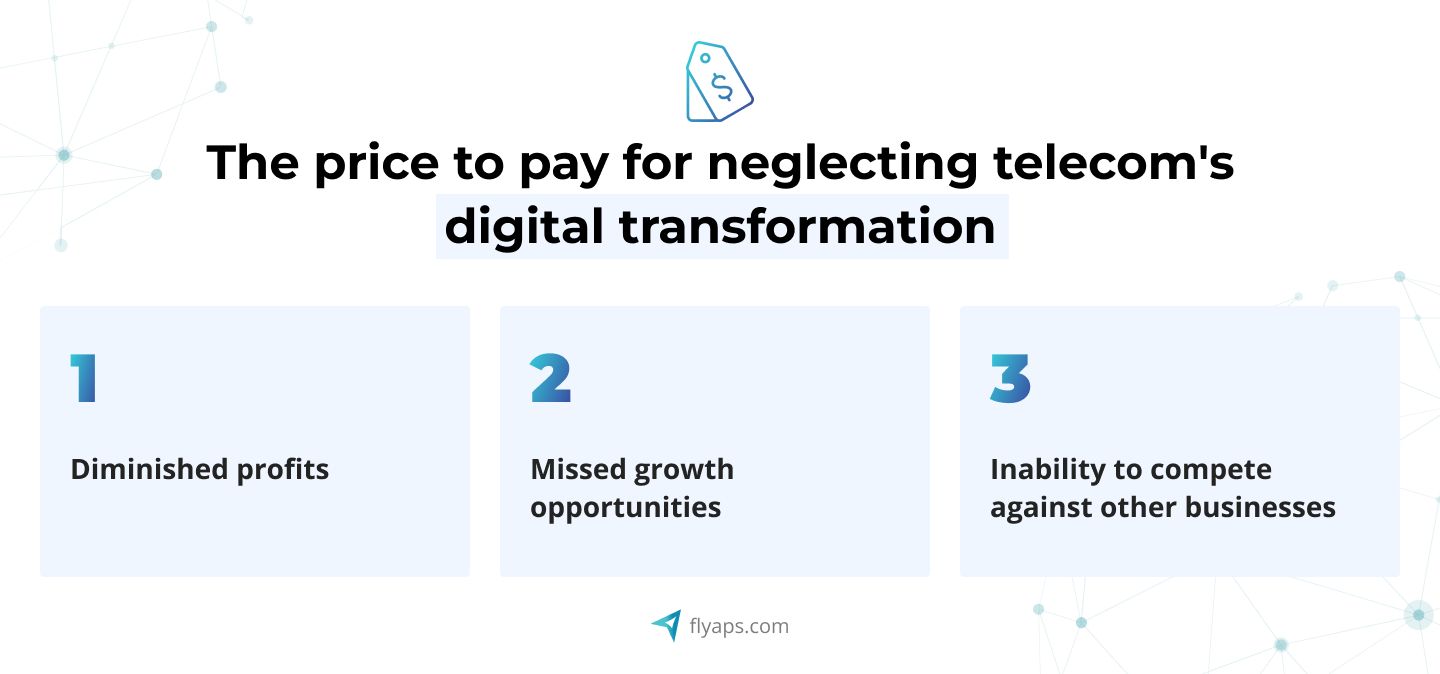
- Diminished profits: Telecom companies may continue to provide their existing services, but their revenue will start to decline over time. As customer expectations shift towards more advanced and innovative offerings, outdated services might lose appeal for their users. As a result, customer s customers will start switching to competitors who have upgraded their technology, and the business will lose in profits.
- Missed growth opportunities: Let’s imagine a situation where a telco delays embracing digital transformation due to budget constraints. During this delay, new technologies emerge, and the demand for high-speed internet and advanced communication services skyrockets. The reluctance of our hypothetical telco to upgrade leads them to lack the infrastructure and capabilities to handle this sudden surge in demand. The outcome? Their existing systems, which have already been operating close to their limits, might struggle to accommodate the influx of new customers seeking high-speed internet connections and advanced communication solutions.
- Inability to compete against other businesses: Let's take the previous example of a company that hesitates to undergo digital transformation and compare them to competitors. Other telecom companies were actively investing in innovative digital technologies, which enabled them to provide better services, streamline operations, and swiftly adapt to changing customer needs. Over time, our imaginary company faces challenges in keeping up with the competitive landscape. Their outdated systems and services hinder their ability to respond promptly to market shifts, making it challenging to compete effectively.
But you shouldn’t consider digital transformation just because of the outcomes. In fact, the benefits and opportunities that come with it are much more appealing, so let’s look at them.
Opportunities digital transformation brings to telecom businesses
Let's delve into some of the most crucial advantages digital transformation brings to the telecom industry:
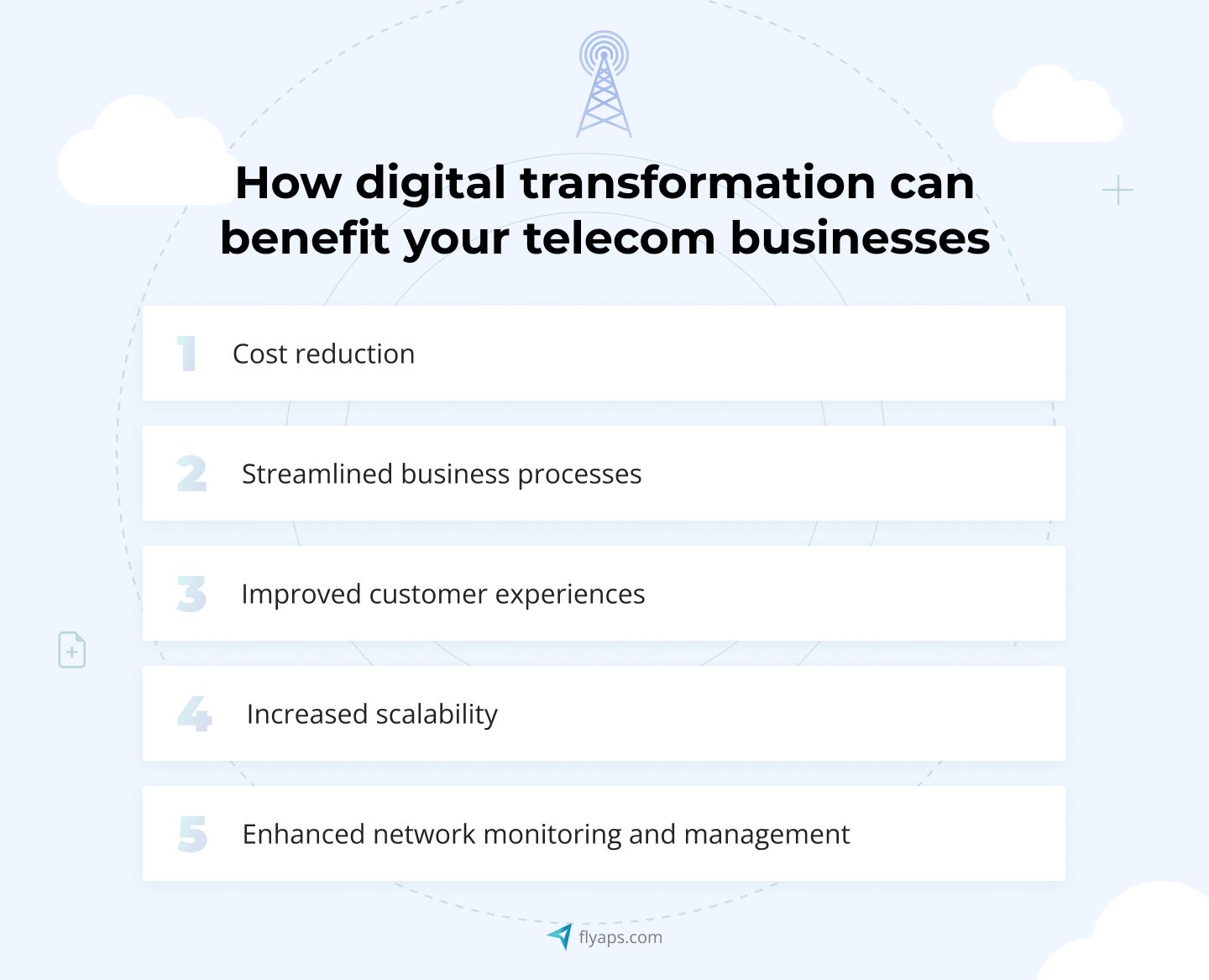
Cost reduction
Digital transformation allows telecom companies to enhance their operational efficiency while cutting unnecessary expenses. Imagine a telecom company whose customer support was mainly manual, requiring a large team to handle inquiries and issues. After introducing an AI-powered chatbot that could handle a significant number of customer queries, the need for a large customer support team to handle numerous repetitive inquiries is gone, leading to significant cost savings and increased customer satisfaction.
Streamlined business processes
With new technologies businesses in the telecom industry make internal processes more efficient and less prone to errors. For instance, consider a telco that used to manage their inventory and billing manually. With digital transformation, the company can implement an automated system that tracks inventory levels in real time and generates accurate invoices. In this example, the automation in the telecom industry helped to eliminate manual errors, reduce paperwork, and free up employees to focus on more strategic tasks.
Improved customer experiences
Telecom companies can enhance digital customer experience and overall service delivery by providing personalized services and quick issue resolution. For instance, let's say a telco incorporated digital transformation by creating a self-service app. This app enabled customers to manage their services, pay bills, and troubleshoot problems on their own. Consequently, this initiative improved the customer satisfaction with the company's services.
Increased scalability
Telecom companies can scale their services with right tech solutions to meet growing demands. Let's say a telco upgraded their network infrastructure to accommodate higher data traffic. So once a new popular streaming service emerges or a similar solution, the company can handle the influx of data without slowdowns or outages, ensuring a seamless experience for users.
Enhanced network monitoring and management
Digital transformation in telecom allows for better monitoring and management of telecom networks. Let’s say your telco struggles with identifying and resolving network issues quickly. With digital transformation, you can implement advanced network monitoring tools that could pinpoint problems in real time. This proactive approach would minimize service disruptions, leading to improved business models and customer satisfaction.
The idea sounds promising in theory, but does telecom digital transformation truly deliver such remarkable results in real-life scenarios? It’s about time we look at the examples!
Examples of digital transformation examples in telecom industry
The experience of leading industry players such as AT&T, Deutsche Telekom and our client NetSpark IP & Telecom and their business models will help us better understand practical results of digital transformation initiatives.
AT&T: using AI, cloud, and cybersecurity to drive digital transformation

After acquiring several companies, AT&T found itself in a tough spot, dealing with scattered data and disjointed systems. Overall, they had more than 6,000 applications, most of them being incompatible with each other. This made it really hard to manage their newly acquired assets efficiently. Costs were soaring, and there was immense pressure to stay ahead in the ever-evolving tech landscape, from 4G to the upcoming 5G.
So, what did they do? They decided to trim down their reliance on ERP and legacy applications and benefit from the power of big data and such technologies as AI and cloud computing to transform their business model.
Understanding the potential of AI and machine learning specifically, AT&T decided to use these technologies to identify replaceable 5G cell sites, predict cyber intrusions, and analyze drone videos for network maintenance purposes.
What’s more, AT&T joined forces with Cisco, one of the leading telecom operators, to improve IoT device management and security, ensuring seamless integration and enhanced functionality of connected devices within AT&T's ecosystem.
Part of their digital transformation strategy were investments in Information and Communication Technology (ICT). Around $10.1 billion went into such essential areas as data centers, communications, networks, applications, and more. AT&T employs these funds for a variety of functions, including internal development, vendor partnerships, and collaborations with consulting firms.
These adaptations allow the company to maintain its leadership position among other telecom companies. As of the first quarter of 2023, AT&T continues to hold the top spot as the leading mobile service provider among other telecom operators in the United States with the market share of approximately 45.9%.
Deutsche Telekom: adapting to technology changes through investments in IoT, big data and blockchain

Dr. Kai-Ulrich Deissner, the Chief Financial Officer at Deutsche Telekom's Board Area Technology & Innovation, is a firm believer in the critical role of digital transformation for the company's ongoing success. He sees this process as more than just a passing trend; it's a profound transformation sweeping through industries worldwide.
His reasoning is straightforward: In the constantly evolving telecom industry, staying competitive and improving the customer experience requires telecom companies to be nimble, creative, and efficient. The key to achieving these goals, according to Deissner, is to fully embrace and accelerate digital transformation. This mindset is at the core of the strategic initiatives in his department, especially if we're talking about adopting new technologies.
Deutsche Telekom are actively investing in ICT solutions. Their yearly ICT spending was about $6.6 billion in 2022, with a significant portion allocated for acquiring and developing software and hardware.
Another area the company started intensively developing is mobile IoT technologies, expanding their NB-IoT network, particularly in smart cities and buildings. They offer business Smart Connect SIM cards, IoT Solution Builder, edge computing platform, and more under their IoT portfolio.
But Deutsche Telekom doesn't stop at bolstering its own digital capabilities. They've leveraged their vast experience in digitalization to assist others, leading to the creation of T-Systems. T-Systems is a specialized IT service provider that offers advisory services, cloud computing solutions, and digital innovations, all with built-in security. By bundling connectivity, data, and applications, T-Systems delivers end-to-end digital customer experiences. While their initial focus is on the German SME sector, their scalable connectivity platforms have the potential to serve a diverse range of customers, extending beyond the borders of the European Union and the United States.
In essence, Deutsche Telekom's proactive approach strengthens their competitive position in the telecom industry. They're already a big player in Germany, holding 38% of the market share. Plus, they have a significant stake of 48.4% in the well-known T-Mobile US. Moreover, digital transformation also positions the company as a catalyst for digital progress in various industries and regions with T-Systems.
NetSpark IP & Telecom: implementing custom RPA-based CRM/ERP for digital transformation
NetSpark IP & Telecom, the US-based company, specializes in telecom consulting. Before they came to us, they lacked automated workflow tools and project oversight solutions. As a result, their staff had to perform all tasks manually, which is challenging in many aspects, especially when determining optimal tariff plans for clients. As an example, up to 10 employees were required to handle this task for a single project.
NetSpark decided to start their digital transformation journey by automating their back-office tasks, so we helped them create a tailored automation solution – a customized CRM/ERP system.
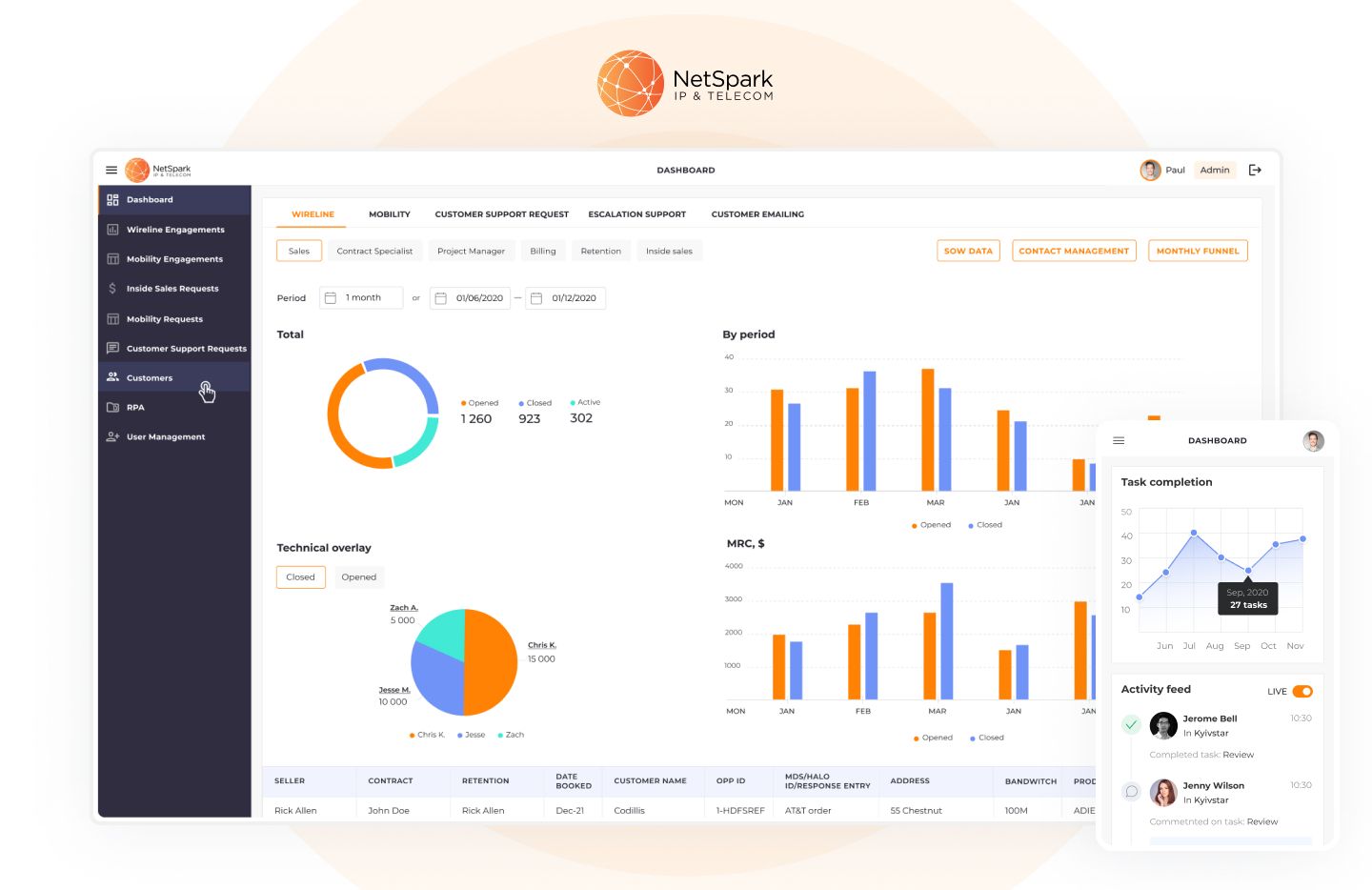
To meet their needs precisely, we started by mapping out their processes. Collaborating closely with leaders from various company departments, we meticulously detailed NetSpark’s business processes. Armed with this valuable roadmap, we then developed comprehensive technical specifications for the project.
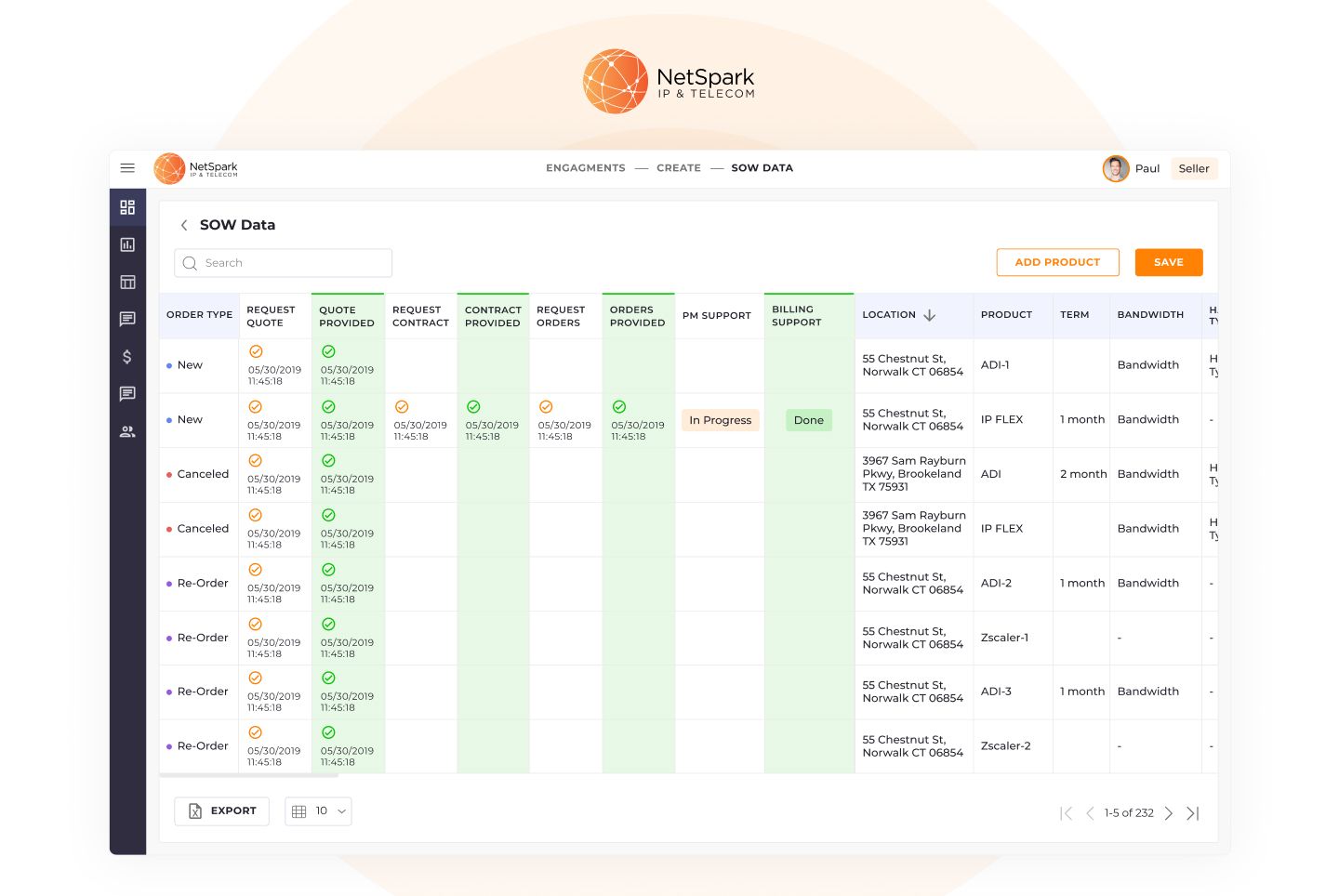
Our dedicated DevOps engineer then entered the stage, establishing advanced CI/CD pipelines that streamlined the release process. This automation marvel allowed the development team to deliver high-quality updates frequently, ensuring a seamless and efficient development cycle. As NetSpark IP & Telecom is dealing with wireline customers, we took special care in designing the CRM/ERP system to accommodate different user roles with varying access rights. This ensured that NetSpark employees, customers, and sub-agents could all benefit from the system's features, each with their unique level of access and permissions.
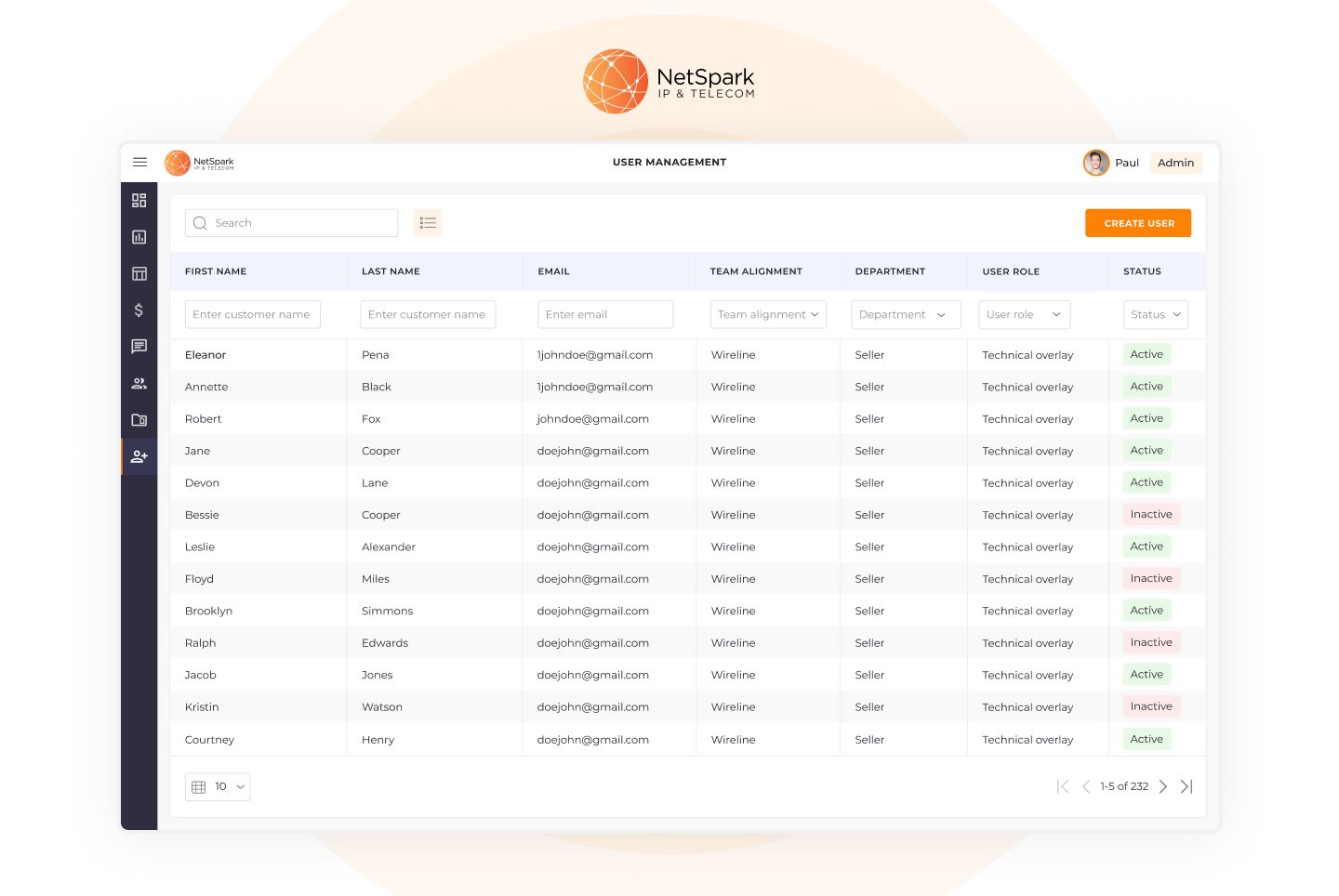
A pivotal feature of the customer relationship management system was an advanced RPA-based calculation tool, which simplified the task of finding the best combination of tariff plans for each client. With its swift calculations and error-free performance, the tool significantly accelerated the process. What used to take three days to complete could now be done in just five minutes.
The first version of the CRM/ERP system was launched within three months. Once the system went live, NetSpark IP & Telecom witnessed a remarkable transformation. Manual workloads were substantially reduced, team performance reached new heights, and revenue surged due to the system's seamless integration into their operations.
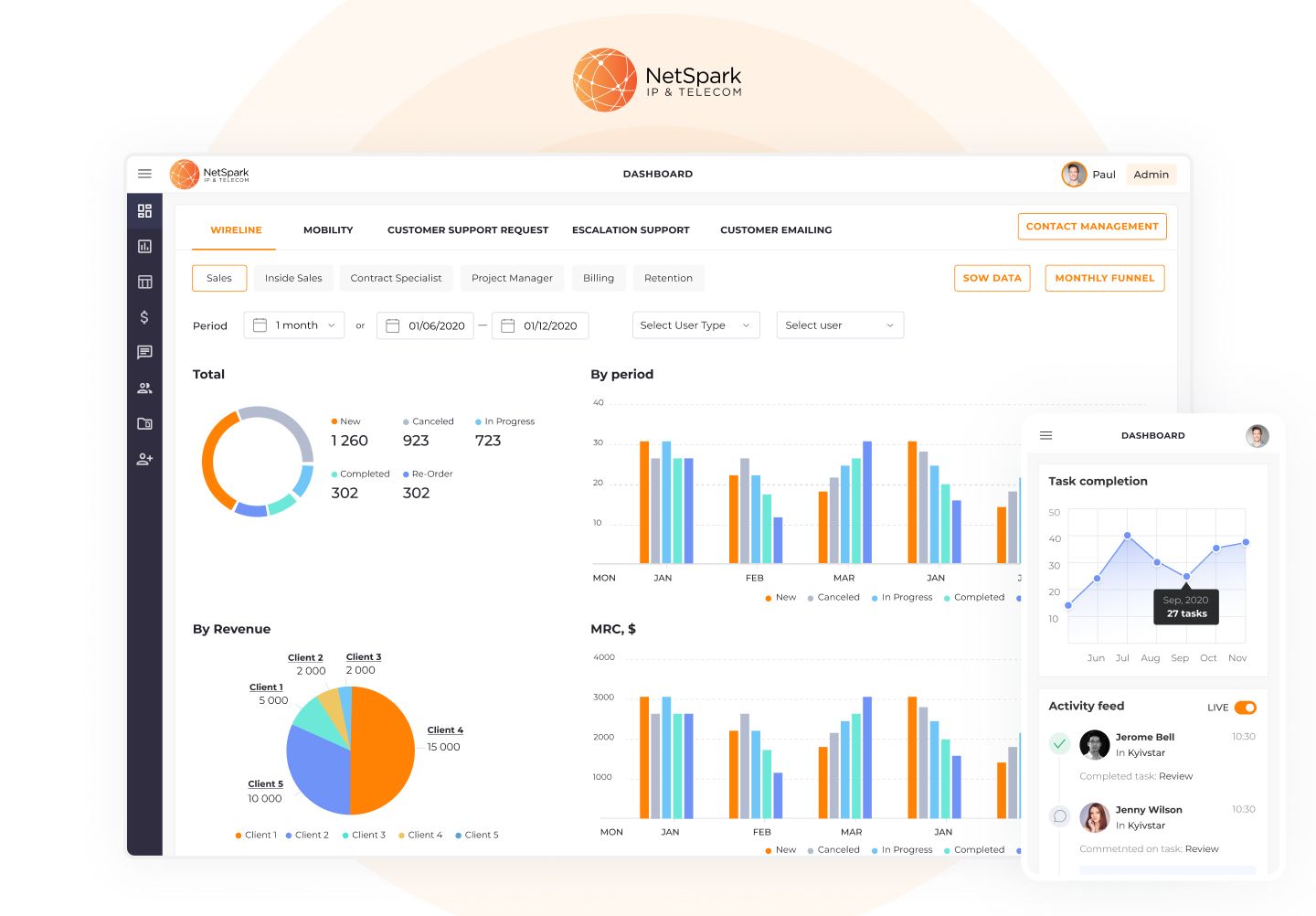
Considering the real-world experience we've just discussed, along with the most promising opportunities in the telecom field, we can come up with pertinent strategies you should focus on.
Telecom digital transformation winning strategies
In the telecom domain, digital transformation strategies are not universal. They must be tailored to the unique needs and aspirations of each telecom company. Still, several key strategies have emerged as fundamental cornerstones for effectively embracing digital transformation:
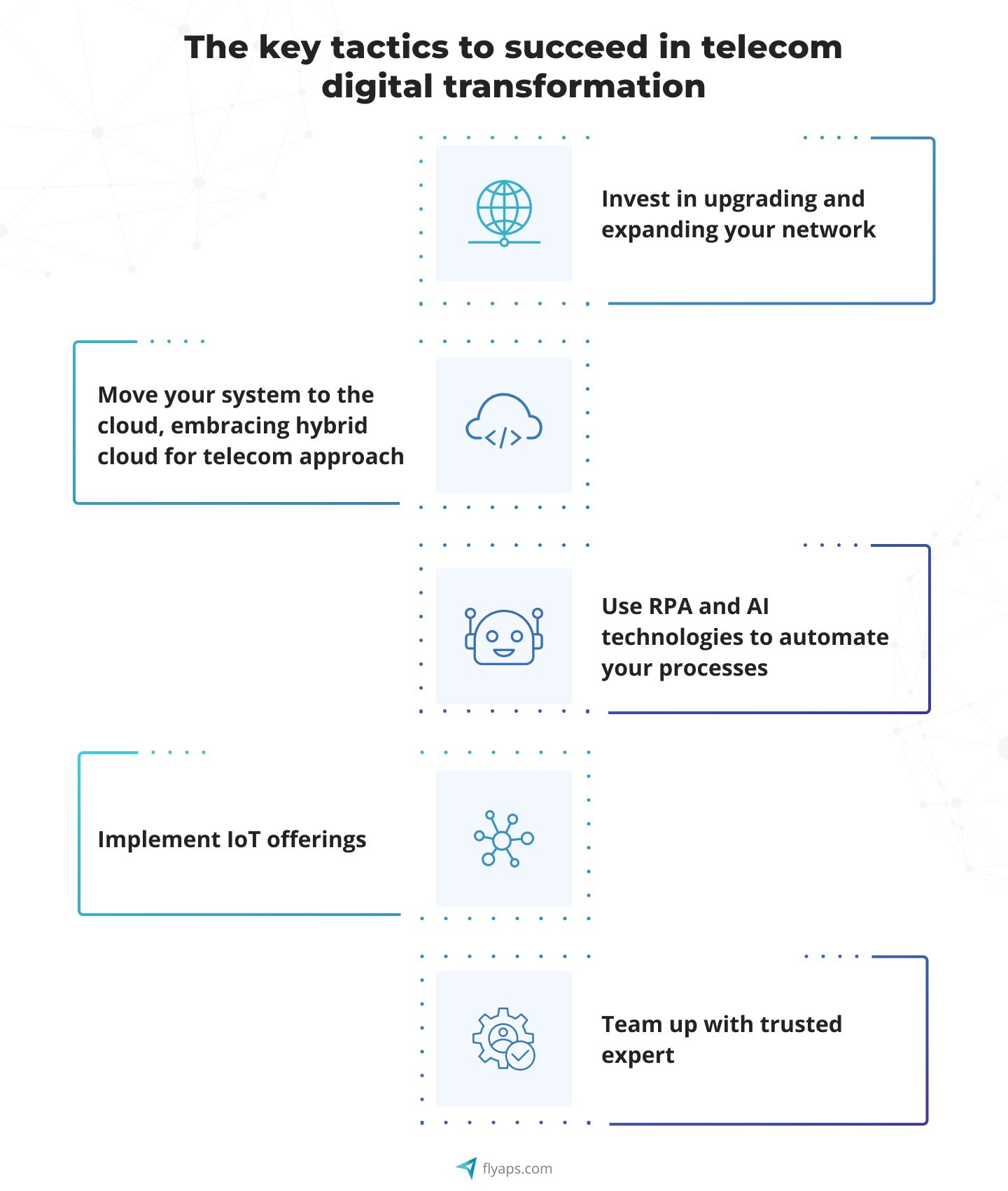
Invest in upgrading and expanding your network: With digital technologies like 5G, cloud computing, and IoT becoming more important, it's essential to invest in modernizing and expanding your network infrastructure. For example, you can consider upgrading your cell towers to support faster internet speeds, allowing customers to enjoy seamless streaming and quicker downloads.
Move your system to the cloud, embracing hybrid cloud for telecom approach: Embracing a hybrid cloud approach for your telecom systems means achieving a seamless connection between your existing on-premises infrastructure and the expansive capabilities of the public cloud. Moreover, this strategy offers cost-efficiency by enabling you to pay only for the additional resources you require in the public cloud when they are needed. In essence, it's a dynamic and budget-conscious way to enhance your telecom operations.
Use RPA and AI technologies and AI development platforms to automate your processes: Robotic Process Automation tools are irreplaceable when it comes to doing repetitive tasks that follow a clear pattern. Think of it as a robot automatically filling out forms or doing math calculations very quickly. Yet, this robot can't work with pictures, charts, or documents that aren't organized. It's not creative either, so it can't figure things out on its own. AI is like the brain that makes the robot smarter. Being AI-driven, it can learn from customer data and make decisions almost like a real human being, recognizing patterns and reading and understanding text.
For instance, such a combination works really well with telecom billing, where RPA can handle regular bills with numbers and words neatly, and AI can deal with invoices in PDFs. You can learn more about automation in the telecom industry in our dedicated article.
Implement IoT offerings: In 2021, the IoT market within telecom services was valued at around $17.4 billion, with expected growth to $254.2 billion by 2031. So it’s an ideal moment to explore IoT in telecom investments. For instance, you can team up with a healthcare company to enable real-time monitoring of medication storage and usage in hospitals and pharmacies, similar to what Vodafone has done. Alternatively, take inspiration from British Telecom Group's comprehensive range of IoT-related services, including IoT connectivity, SIM card provisioning, and secure networks for various devices.
Team up with trusted experts: When telecom companies want to go digital, it's crucial to find experienced and trustworthy tech companies to work with. These experts can make your journey go smoother and help overcome any tricky problems that might pop up. By teaming up with partners who really know the ins and outs of the telecom world, you make sure the tech you choose fits your business goals and works seamlessly with what you're already doing. It's like having a trusted guide on a challenging hike, making sure you reach your destination without any hiccups.
How Flyaps can help you with digital transformation in telecom
At Flyaps, we have been helping telecommunication companies transform their internal operations and offerings with tailored software solutions since 2013. Here’s what distinguishes us and makes telco businesses partner with us for their telecom digital transformation:
Hybrid cloud integration: We will meticulously assess your requirements, ecosystem strategies, budget constraints, and operational needs to devise a hybrid cloud integration plan that lets you get all the advantages of private and public clouds. This approach guarantees a scalable and flexible infrastructure, enabling your business to dynamically manage workloads, optimize resource utilization, and respond swiftly to changing market demands.
Custom IoT platform development: We can aid in the creation of bespoke IoT platforms tailored to your telecom company's specific services. These platforms can seamlessly manage the data influx, ensure robust security protocols, and offer advanced analytics capabilities. By streamlining IoT services, Flyaps can facilitate efficient device management, data interpretation, and enhance customer experiences.
Management and automation strategy: Flyaps excels in assisting telecom companies in formulating comprehensive data management and automation strategies. By collaborating closely with your team, we can determine the most crucial areas for automation. This includes selecting the appropriate tools to effectively manage the cloud environment, automating internal processes, and, ultimately, enhancing operational efficiency. Through careful planning, Flyaps ensures that your digital transformation experience is not only technologically sound but also operationally smooth.
Advanced analytics implementation: With advanced analytics solutions you can gain insights from the massive volumes of customer data generated by various telecom operations and customer interactions. By harnessing this data, you will be able to make informed decisions, predict trends, optimize resource allocation, and refine your service delivery based on customer behaviors and preferences.
Looking for some help to start your digital transformation journey? Drop us a line and we'll be happy to discuss the details.



